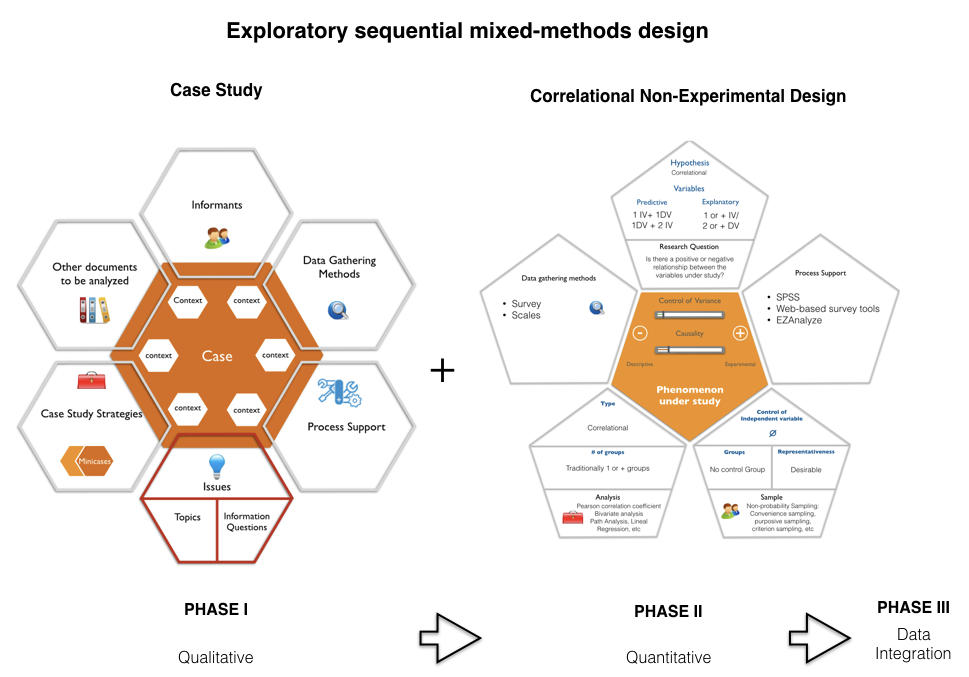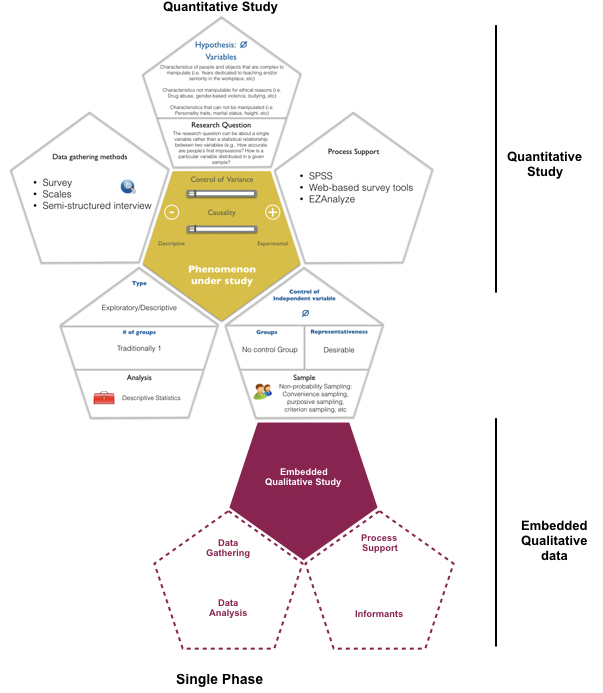There are three main types of mixed-methods designs: Convergent parallel, Exploratory sequential; and Explanatory sequential. You can find a description of each of them in the tabs above.
The previous three basic designs can then be used in more advanced mixed methods strategies.
For instance, transformative mixed methods is a design that uses a theoretical lens drawn from social justice or power as an overarching perspective within a design that contains both quantitative and qualitative data. The data in this form of study could be converged or it could be ordered sequentially with one building on the other.
An embedded mixed methods design involves as well either the convergent or sequential use of data, but the core idea is that either quantitative or qualitative data is embedded within a larger design (e.g., an experiment) and the data sources play a supporting role in the overall design. A multiphase mixed methods design is common in the fields of evaluation and program interventions. In this advanced design, concurrent or sequential strategies are used in tandem over time to best understand a long-term program goal.
The following clip summarizes the main types of mixed-methods designs
| Once you have picked one mixed-methods research design, you can use the following links in order to generate a visual representation of the different key elements in your design: |
|
Convergent parallel mixed methods is a form of mixed methods design in which the researcher converges or merges quantitative and qualitative data in order to provide a comprehensive analysis of the research problem. In this design, the investigator typically collects both forms of data at roughly the same time and then integrates the information in the interpretation of the overall results. Contradictions or incongruent findings are explained or further probed in this design.
Exploratory sequential mixed methods is the reverse sequence from the explanatory sequential design. In the exploratory sequential approach the researcher first begins with a qualitative research phase and explores the views of participants. The data are then analyzed, and the information used to build into a second, quantitative phase. The qualitative phase may be used to build an instrument that best fits the sample under study, to identify appropriate instruments to use in the follow-up quantitative phase, or to specify variables that need to go into a follow-up quantitative study. Particular challenges to this design reside in focusing in on the appropriate qualitative findings to use and the sample selection for both phases of research.
Explanatory sequential mixed methods is one in which the researcher first conducts quantitative research, analyzes the results and then builds on the results to explain them in more detail with qualitative research. It is considered explanatory because the initial quantitative data results are explained further with the qualitative data. It is considered sequential because the initial quantitative phase is followed by the qualitative phase. This type of design is popular in fields with a strong quantitative orientation (hence the project begins with quantitative research), but it presents challenges of identifying the quantitative results to further explore and the unequal sample sizes for each phase of the study.
An embedded mixed methods design involves as well either the convergent or sequential use of data, but the core idea is that either quantitative or qualitative data is embedded within a larger design (e.g., an experiment) and the data sources play a supporting role in the overall design. A multiphase mixed methods design is common in the fields of evaluation and program interventions. In this advanced design, concurrent or sequential strategies are used in tandem over time to best understand a long-term program goal.
The following tool will help you choose the research design (open in new window):








